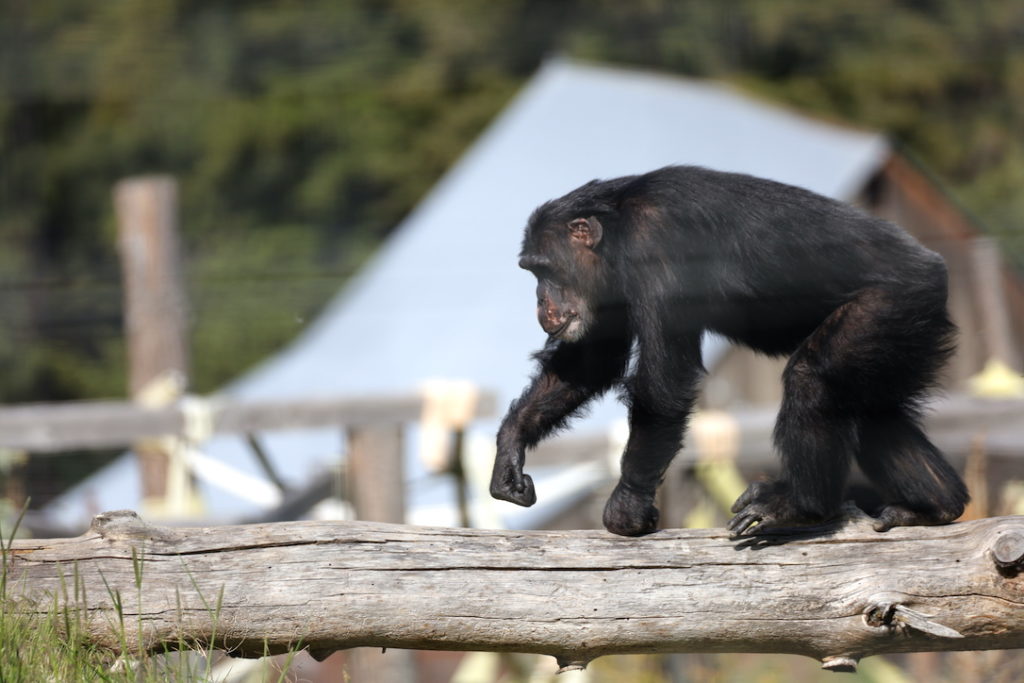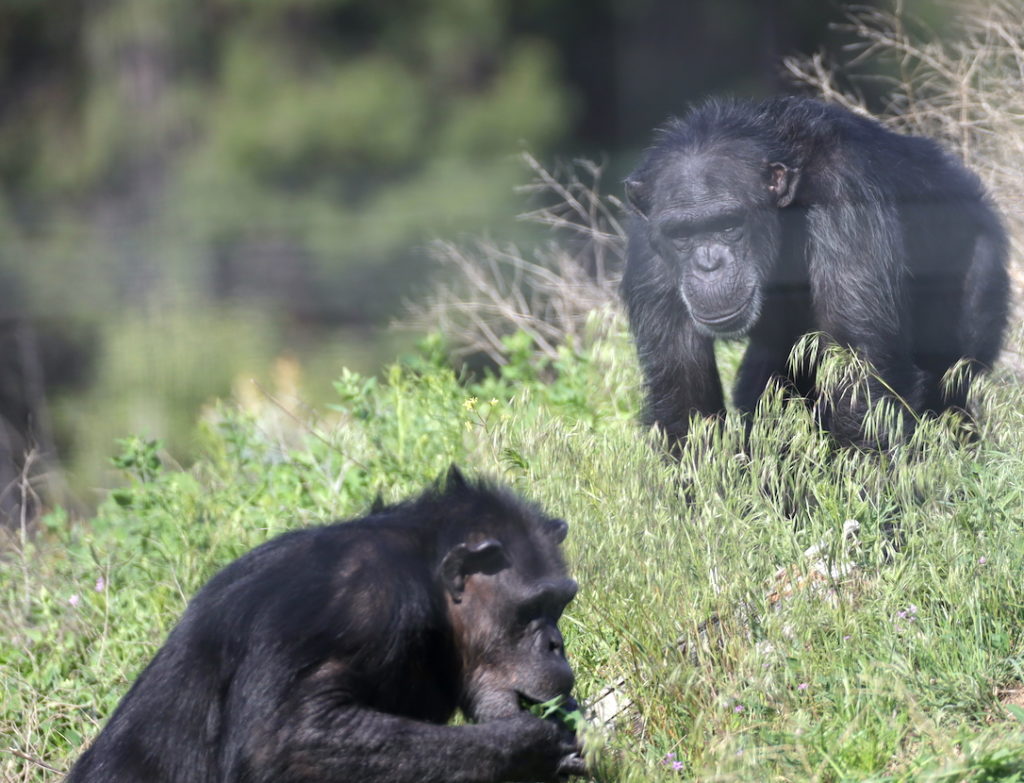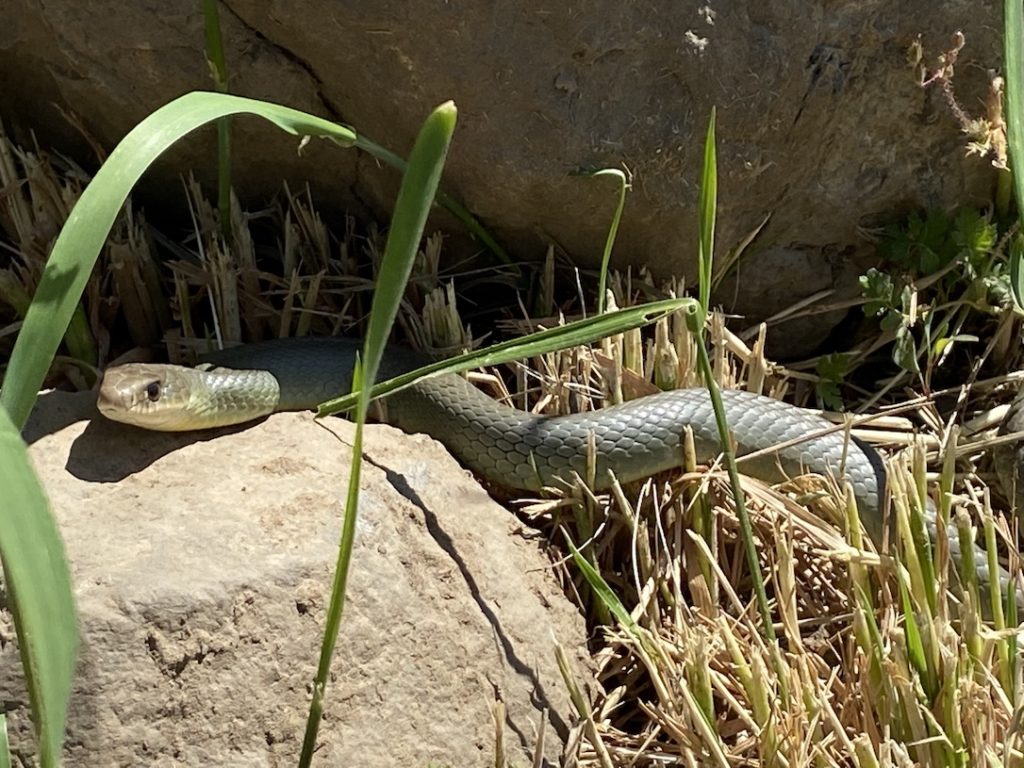As I opened up the door that leads to Young’s Hill this morning, Burrito bolted out and we went for our morning jog.
As we were headed toward the final stretch around the hill, he turned back around and began running up the other way for Lap 2.
As we were heading back up the hill, we heard Annie screaming. My initial thought was she saw a snake. As any nearby chimpanzee converged on Annie’s location, my heart raced. We have begun trying to recall the chimpanzees off the hill after a snake sighting to ensure a venomous snake didn’t somehow make it’s way through the fence. As Missy, Jamie, Foxie, and Burrito met with Annie, her screaming and calls stopped and she began foraging for some of the prickly lettuce. What did she see? I still don’t have a clue, and none of the others seemed to know why she was creating a fuss either as they shot her looks of confusion as well.
Nonetheless, that didn’t stop the others in searching for a phantom menace.







Soon after, they heard the food grunts of staff to let them know breakfast was ready and about to be served.
While the chimpanzees and cattle call this plot of land their home, so do a great deal of other amazing creatures. So let’s meet some of them! (Note: I use a couple of apps on my phone to help identify them, they aren’t 100% accurate, but usually lead me to the right direction. So If I misidentify someone here, please let me know!)
White-tail Deer
Deer can be found grazing most of the year right outside our gate. Every year, its always the sight to see when there is a mom and her fawns.
Yellow-bellied Marmot
Marmots are found mostly during the spring, summer and fall, and retreat to their dens for the duration of winter. This particular individual caught me laying on the ground, catching my breath last summer after going around Young’s Hill with Burrito three times in a row.
***Warning: The next set includes insects, amphibians, and reptiles. If you don’t like those these types of creatures, you can probably skip the rest***
Virginian Tiger Moth
I found this moth right outside the Greenhouse one day after cleaning. It was very beautiful and I could not resist taking a photo of it. Before the chimpanzees regained access to the Greenhouse, I relocated them to someplace a little safer.
Sphinx Moth
I had trouble confirming the species of this sphinx moth. It does seem that it is leaning toward a Wild Cherry Sphinx Moth. It was huge and very beautiful! I found it right outside the construction area (you can spot Honey B in the back watching me take photos of them). Though sphinx moths are extremely beautiful when their wings are open, this one was resting and I didn’t want to bother it. Still beautiful though, if you ask me!
Praying Mantis
I’ve never really come across a praying mantis that was willing to pose as long as this one. This one was found right outside the door one day.
Dragonfly
I couldn’t find the identification for this one, though it may be a lance-tipped darner… maybe? I was cleaning the Seven’s Playroom one day and this fella took me by surprise as I walked passed a window and it flew out. I was able to catch it (with the aid of a few pieces of paper) and released it outside.
Long-toed Salamander
Long-toed salamanders are one of the most common creatures we find in the Chimp House, particularly the drains. This guy was found in such place and was released near one of the ponds on the property.
Northern Pacific Tree Frog
This is THE most common creature found in the Chimp House in the spring and summer if you ask me. And they are found…
every….
where!
One thing that always fascinates my the range of color they come in. From a dull brown to a vibrant green, they are pretty regardless. And their evening songs sooth the soul. When we catch them, they are usually released near one of the ponds.
Garter Snake
This is one of the most featured snakes in videos of past, like here, here, here, or here (and please keep in mind these videos have been taken over the course of several years). They are usually found near the grape vines. The are non-venomous and pretty docile. They try to hide from anything they see as a threat (human or chimpanzee), and will generally hide from it. Though they are great hiders, Annie is a great seeker and usually spots them even if they are on the other side of the fence.
Northern Rubber Boa
The northern rubber boa is a constrictor that is the most northern of all constrictors. I didn’t realize it at the time how they can be somewhat elusive and hard to find. This guy came to us in the Chimp House one day, and I didn’t realize how lucky I was one bestowed us with its presence. And don’t worry, they are non-venomous, rather small, and extremely docile! I have never seen a snake this docile!
Western Racer Snake
This snake is also a non-venomous snake that is seen a good chuck of times on the sanctuary’s grounds. They are very quick and adults are usually a grey color with a tint of green. The baby racers are slightly different.
Their pattern resembles that of another, more dangerous, snake. This is an adaptation feature they gained to try to ward off any potential predators. This little guy found it’s way along the fence trying to get to the other side, so I happily obliged him. Happy for him, and happy for the chimpanzees. It was a win-win situation.
Pacific Gopher Snake
Gopher snakes have been seen on the property, though they don’t really come near the Chimp House like the others. As you can see, they have very distinctive markings again, similar to another, more dangerous snake. However, gopher snakes take is a step further. If they feel threatened, they will coil up, flatten their head, and if near dead leaves or dry brush, will shake their tail. These guys go through great lengths to be left alone from would be predators. I found this guy on the driveway near the street as I was leaving work one day. I was scared I almost hit him. But he was okay and made myself seem as nonthreatening as I could. He later uncoiled and slithered his way in to some brush in the adjacent property.
You may be wondering, if both racers and gopher snakes adapted these traits to look so much like their more dangerous cousin, how to we know how to tell them apart? We as staff have been trying to hone in on our identification skills to be able to identify a snake as quickly as we possibly can. One way to tell is the tail. We have trying to pay close attention to spot that (along with other key traits). For instance, in the case of this gopher snake, through his clever disguise, I saw right through his bluff. My key was his tail.
They are long, slender, and to a point. Their cousin’s tails have a rattle on them, which make noise, and never come to a point like this. Even as a juvenile or when shedding, their tails are bulbous.
There more amazing creatures who live around the sanctuary property that I either didn’t have a good photo of, or have been featured in other blogs, such as bobcats, coyotes, elk during their migration, and hundreds of birds! Though we care for ten chimpanzees (soon 16!) and four bovine, we like to think this piece of property in central Washington is a sanctuary for these creatures from being harassed or killed for living their life as well. We have a catch and release protocol for any that find their way onto the wrong side of the fence. Though we keep them out of the chimpanzee side of the fence, most of the rest of the property is theirs to explore. And for those not new to the blog who may be wondering, we have been hard at work fortifying our fences and security measures so events such as last year are mitigated more so, though that was a first in the (going on) 13 years.
Have a great day, everybody!

























